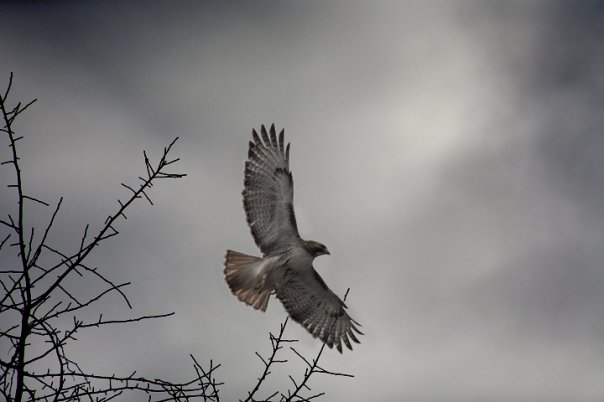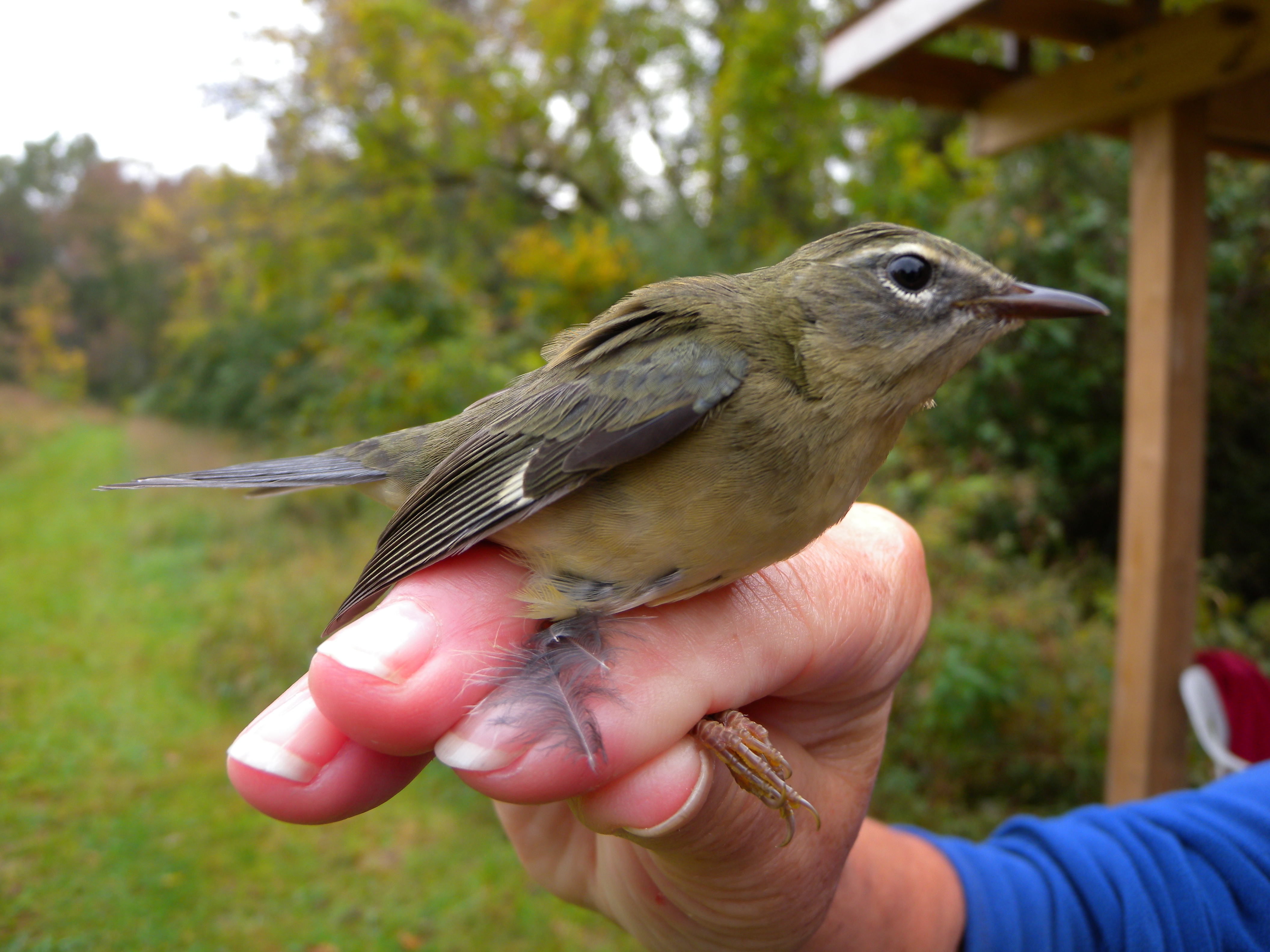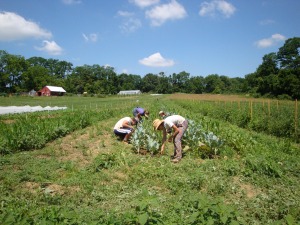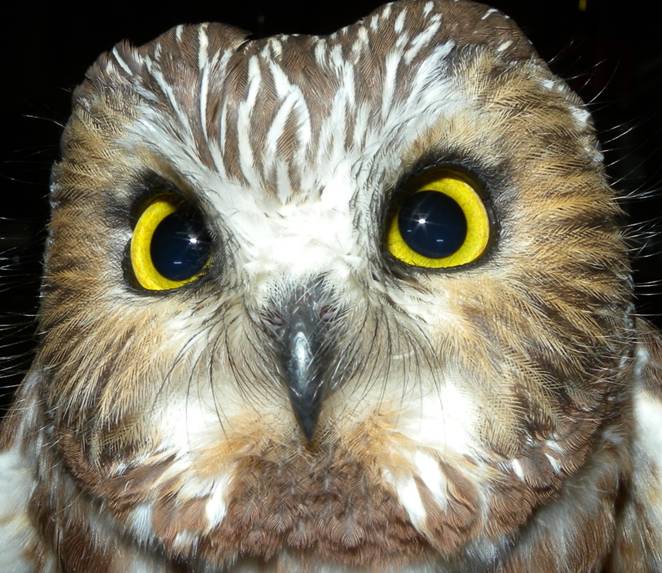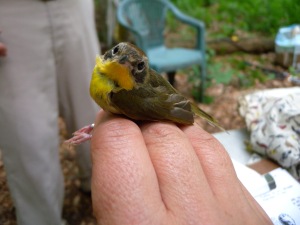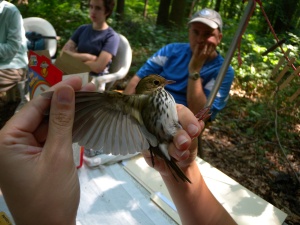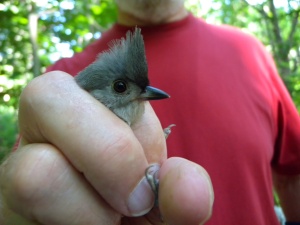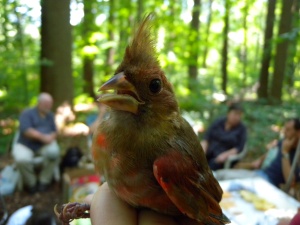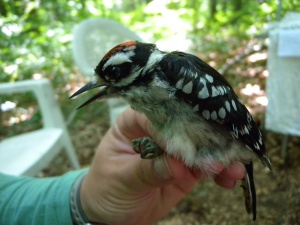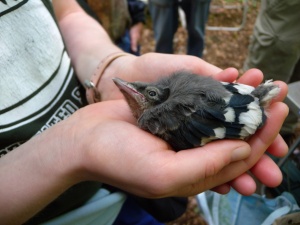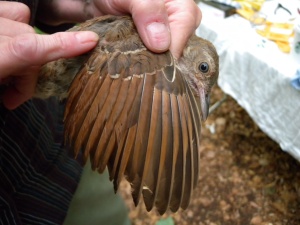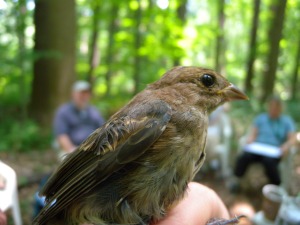
Last Friday (10-14), we banded 56 birds to the delight of my adult class (age 50+) from Widener’s Osher Lifelong Learning Institute. After studying birds, bird banding and bird conservation in the classroom, the enthusiastic students came out to Rushton Woods Preserve to experience the banding production in person. They were thrilled to touch and be so close to these wild feathered beauties and were pleasantly surprised at the diversity of species: Eastern Phoebe, 5 Palm Warblers, 3 Myrtle Warblers, 1 Common Yellowthroat, 4 Black-throated Blue Warblers, lots of sparrows, 1 Gray-cheeked Thrush, towhee, goldfinch, cardinals, Carolina Wren, and 1 late CATBIRD!
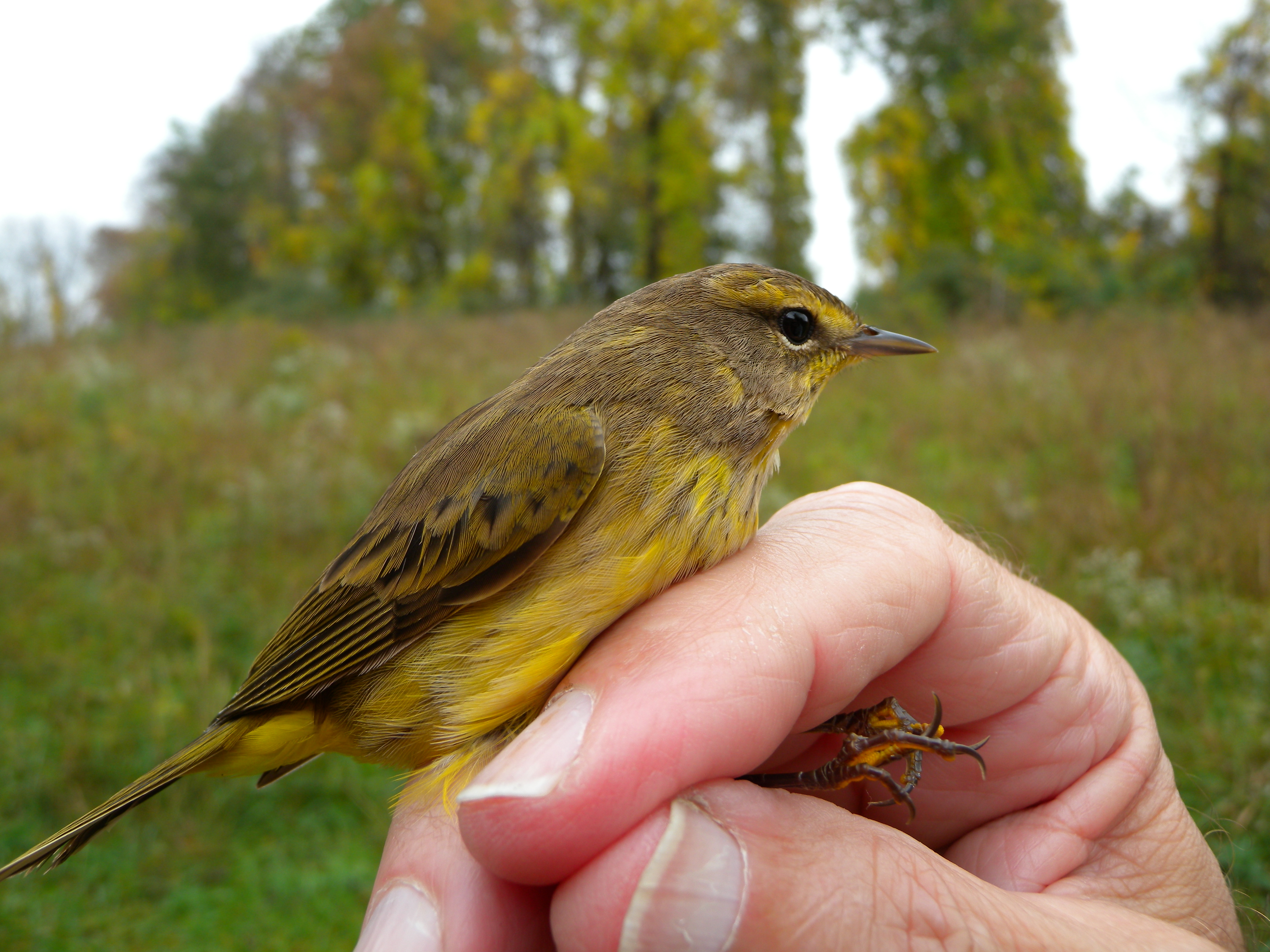
The net over the compost pile was very busy that day with over 15 birds in the net at once during the mid-morning net check. Doris was packing 2-3 birds of the same species in each bag (we need more hand-made bird bags if you can sew and want to lend a hand!). Poor Doris also suffered deep puncture wounds during that same net check from an ungrateful mole or vole that she rescued from the net. “Don’t get no respect, even from rodents!”, she cried.
This past Tuesday (10-18) was our second big fallout day, probably the last one for this fall. We banded 93 birds of 20 species, which is 7 birds over Rushton’s previous record of 86! A Northern Parula Warbler was the best of 6 warbler species, and several Golden-crowned Kinglets were new for this year. Our loyal volunteers Alice, Lou, and Godefroy extracted non-stop and kept the birds safe. Win and Justin helped at the open and went to work saying, “Here are 6 birds. There are 2 more in #7 and 12 in #6.” That was 7:45 and we never stopped until after 10. Doris says, “No bird was held more than 90 minutes, which is long for Rushton, but nothing for the big banding stations which routinely hold birds for longer.”
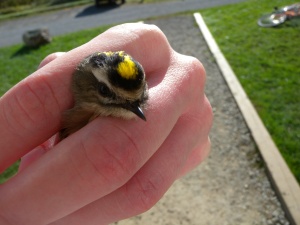
Thursday and Friday of this week were slower, with probably more High School kids than birds. About 100 honors students from Conestoga High School’s Environmental Science class came out to Rushton over the past two days. They had the chance to visualize and experience concepts they have learned or will learn in the classroom this year by rotating through 3 stations: a woodland ecology walk, tour of the sustainable CSA farm, and bird banding and conservation. The students were impressed with the common birds we all sometimes take for granted like the handsome American Robin and Northern Cardinal and the charismatic Tufted Titmouse. The very last catch of the day was a stunning Sharp-shinned Hawk, which the kids got really excited about. The cell phones immediately came out of pockets and were snapping pictures left and right! This is probably the same hawk that we have occasionally seen darting in and out of the hedgerows and even dive-bombing Lisa one day as she was closing the nets. I think the Sharpie was angry that she wasn’t leaving the net up to facilitate his lunch endeavors.

As for the Northern Saw-whet Owls (NSWO), we were off to a very slow start. For the first couple of weeks, we ended up empty-handed every night except for a red-phase Eastern Screech Owl two Fridays ago at 8pm and then again at 11pm. He just couldn’t get enough of our nets, apparently. Let’s just hope he has learned his lesson and stays away once we really start catching saw-whets (screech owls are a predator of NSWO, believe it or not).
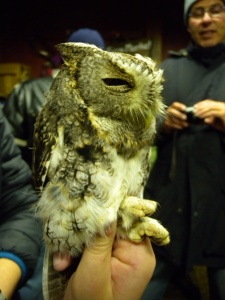
We don’t know what’s taking the Saw-whets so long, but it may be related to this crazy wet weather we have been having (which seems to have delayed this year’s songbird migration as well). There is also some speculation that this year was not a very successful breeding year for the NSWO, and therefore the number of young “Hatching Year” (HY) birds is much lower than last year. Since most of the owls we band are HY birds, we don’t expect to band as many this year as last. (The older more dominant males tend to prefer to stick out the winter on their northern territories rather than migrating south with the young owls and the females. )
The NSWO is also an irruptive species closely tied to the pine tree seed crop up north. Last year was an irruption year during which we had more saw-whets coming south than usual because the pine trees did not produce as many seeds as the previous year, which caused the rodent population (owl food) to plummet. When food up north is scarce, more owls travel south for the winter. Bird migration is related to food scarcity, not cold weather. Most birds, even some hummingbirds like the Rufous, are well adapted to dealing with cold weather.

You can imagine our delight last night (10-21) when we finally caught our first Northern Saw-whet Owl!!! It was a cute-as-a-button feisty young female weighing in at about 92 grams. It was about 9:00 at night when she found her way to our nets while investigating our audio lure that incessantly plays the male’s territorial call. Everyone was ecstatic, and even men’s voices were raised an octave or two as they ‘ooed’ and ‘aahed’ over the little owl. As for myself, I was a little intimidated by her mesmerizing yellow eyes that seemed to be boring into my soul from some wild place and “reading my mind”, as one woman said.
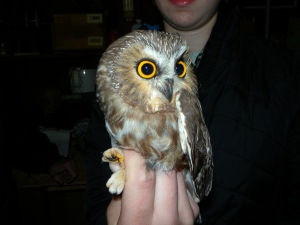
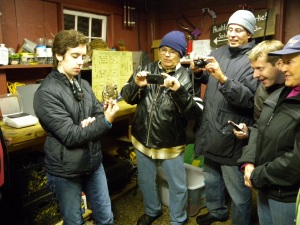
Alas, there is hope for this year’s owl banding season! Remember to contact Lisa Kiziuk (lkr@wctrust.org) if you are interested in observing owl banding. Songbird banding will also continue on Tuesday and Thursday mornings for the next couple of weeks. No reservation required for songbirds.
And speaking of Lisa, congratulations to her on winning the DVOC (Delaware Valley Ornithological Society) Rosalie Edge Conservation Award for her tireless bird conservation work! Without her vision, the Willistown Conservation Trust’s banding station at Rushton Woods Preserve would never have become a reality. Today, the Rushton bird banding station is not only a reality but a wonderful destination where adults and children of all backgrounds experience some of nature’s finest works of living art while learning about the importance of such scientific research in the understanding and ultimate conservation of our nation’s feathered bounty. Thank you, Lisa, for making your dream come true and for all you do for the birds. I know Rosalie Edge would be proud of you.
~Blake


